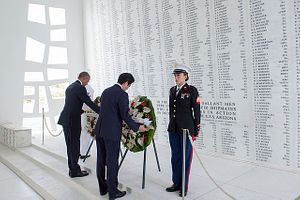In 2016, Prime Minister Shinzo Abe visited Pearl Harbor to commemorate the U.S. soldiers who died there, and President Barack Obama visited the Peace Memorial Park in Hiroshima to commemorate the victims of the atom bomb. The visits remembered the conflict that raged in the Pacific for three years and eight months from December 1941 to August 1945, a conflict that brought with it great sacrifice, hatred, and bigotry in both Japan and the United States.
How do nations transcend hatred, reconcile, and build a constructive future after fighting a long and brutal war? Human psychology is complex, and in the case of a one-sided victim-aggressor relationship, there is a tendency to criticize, censure, and exact revenge rather than to reconcile. At Pearl Harbor, the surprise attack by the Japanese military ahead of a formal declaration of war single-handedly inflicted defeat and the worst military humiliation in the history of the United States. The American people had been hesitant to intervene in the war in Europe and Asia, but attitudes changed overnight with a push for revenge on the Japanese under the slogan “Remember Pearl Harbor.”
On the other hand, dropping the atom bombs on Hiroshima and Nagasaki when the defeat of Japan was but a matter of time, killing or wounding several hundred thousand civilians in both cities, was a massacre and destruction on a scale out of proportion to Pearl Harbor. Under the close postwar alliance between Japan and the United States, Hiroshima and Nagasaki were never turned into openly anti-American symbols in Japan, but the use of weapons of mass destruction on cities and other non-military targets precipitated complex feelings toward the United States among the Japanese. It is hardly surprising that even though more than seventy years have passed since the end of the war, some quarters in both Japan and the United States called on the other country to apologize at last year’s visits to Pearl Harbor and Hiroshima by the two leaders.
In contrast, it is easy to reconcile when both parties have inflicted injury on each other. In this sense, Iwo Jima is the invisible symbol of reconciliation between Japan and the U.S. Between February 19 and March 26, 1945, a Japanese Army and Navy garrison of approximately twenty thousand men engaged in bloody combat with approximately sixty thousand U.S. Marines who came ashore on the island. At the end of thirty-six days of mortal combat under the command of Lt. General Tadamichi Kuribayashi, the Japanese garrison had been nearly obliterated, but despite their victory, the U.S. Marines had suffered more casualties than the Japanese garrison did. The image of the Marines planting the Stars and Stripes atop Mount Suribachi became the symbol of the hard-won American victory in the Second World War. The Japanese and American soldiers who fought so bravely on this small island recognized each other’s strength and willpower even as they engaged in tragic bloodshed.
Every year in early December, all third-year cadets at the National Defense Academy (the school providing joint officer training for the Japanese Ground, Air and Maritime Self-Defense Forces) go to Iwo Jima for training. The cadets form platoons or companies and tour every cranny of the important points on the island to conjure up the traces of the ferocious fighting. At the point where the U.S. Marines came ashore, the cadets imagine the terrible spectacle that confronted the Marines as they ran toward the sand dunes where the pillbox defenses of the Japanese garrison were ready and waiting for men who had nothing to shield them from gunfire. Then the cadets stoop to enter the ruins of the cramped pillboxes of the Japanese garrison to reflect on the hopeless lot of the Japanese soldiers who took on the overwhelmingly superior landing troops. By cultivating this kind of empathy, the cadets renew their resolve to defend the nation, but they also fully absorb the calamities that war inflicts on the young.
Every year since 1985, forty years after the end of the war, both Japanese and American participants in the war, or their surviving family members, have attended a joint service for the war dead on Iwo Jima. Lawrence Snowden, retired lieutenant general in the U.S. Marine Corps, who experienced the hell of Iwo Jima as a young soldier, and Yoshitaka Shindo, member of the House of Representatives and the grandson of Lt. General Tadamichi Kuribayashi, the supreme commander of the Japanese garrison killed in the fighting, have attended the memorial services in the past. Those who know what happened on this island are once again reminded of the far greater rewards of Japan and the U.S. working together, rather than waging war.
On his visit to Pearl Harbor in December last year, Abe quoted an address by President Abraham Lincoln, whose image graces the Lincoln Memorial in Washington D.C. “With malice toward none, with charity for all […] let us strive on […] to do all which may achieve and cherish a […] lasting peace among ourselves and with all nations.” During the American Civil War, armies of the Union and the Confederate States engaged in fierce fighting at Gettysburg, and this is where Lincoln mourned the soldiers on both sides who had fallen on the battlefield, speaking in favor of reconciliation between the two Americas in the interest of a common future. Today, more than seventy years have passed since the end of World War II and Iwo Jima has become the “Gettysburg in the Pacific” for both Japan and the United States.
Haruo Tohmatsu is a professor in the Department of International Relations Studies at the National Defense Academy.

































